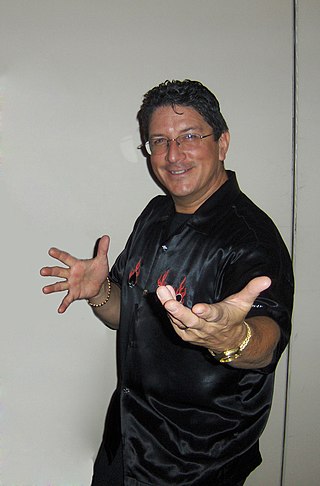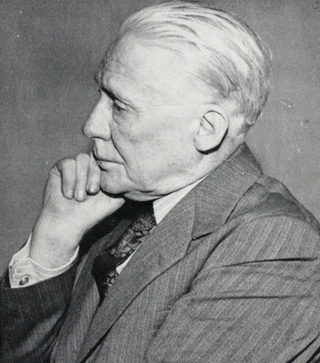Related Research Articles

The cups and balls is a performance of magic with innumerable adaptations. Street gambling variations performed by conmen were known as Bunco Booths. A typical cups and balls routine includes many of the most fundamental effects of magic: the balls can vanish, appear, transpose, reappear and transform. Basic skills, such as misdirection, manual dexterity, sleight of hand, and audience management are also essential to most cups and balls routines. As a result, mastery of the cups and balls is considered by many as the litmus test of a magician's skill with gimmick style tricks. Magician John Mulholland wrote that Harry Houdini had expressed the opinion that no one could be considered an accomplished magician until he had mastered the cups and balls. Professor Hoffman called the cups and balls "the groundwork of all legerdemain".
Sleight of hand refers to fine motor skills when used by performing artists in different art forms to entertain or manipulate. It is closely associated with close-up magic, card magic, card flourishing and stealing. Because of its heavy use and practice by magicians, sleight of hand is often confused as a branch of magic; however, it is a separate genre of entertainment and many artists practice sleight of hand as an independent skill. Sleight of hand pioneers with worldwide acclaim include Dan and Dave, Ricky Jay, Derek DelGaudio, David Copperfield, Yann Frisch, Norbert Ferré, Dai Vernon, Cardini, Tony Slydini, Helder Guimarães and Tom Mullica.

Card manipulation is the branch of magic that deals with creating effects using sleight of hand techniques involving playing cards. Card manipulation is often used in magical performances, especially in close-up, parlor, and street magic. Some of the most recognized names in this field include Dai Vernon, Tony Slydini, Ed Marlo, S.W. Erdnase, Richard Turner, John Scarne, Ricky Jay and René Lavand. Before becoming world-famous for his escapes, Houdini billed himself as "The King of Cards". Among the more well-known card tricks relying on card manipulation are Ambitious Card, and Three-card Monte, a common street hustle also known as Find the Lady.
A trick deck is a deck of playing cards that has been altered in some way to allow magicians to perform certain card tricks where sleight of hand would be too difficult or impractical.

David Frederick Wingfield Verner, better known by his stage names Dai Vernon or The Professor, was a Canadian magician.
Out of This World is a card trick created by magician Paul Curry in 1942, in which an audience member is asked to sort a deck into piles of red and black cards, without looking at the faces. Many performers have devised their own variations of this trick. It is often billed as "the trick that fooled Winston Churchill" due to a story describing how it was performed for him during World War II. The method behind the trick is simple and essentially self-working, and can be enhanced by the presentation of the performer and the use of other principles of magic.

Tony Slydini, simply known as Slydini, was a world-renowned magician. His mastery, expertise, originality and innovative approach to close-up artistry magic, earned him a legendary reputation in the magic world. He traveled the world performing for the public as well as performing and lecturing fellow magicians. As a result, he served as an inspiration to generations of well-known magicians, celebrities and entertainers, including Doug Henning, Dick Cavett, Bill Bixby, Ricky Jay, David Copperfield and countless others. Although he was best known as a master of close-up artistry, he continually demonstrated an extraordinary performing ability and during his lifetime was responsible for a long series of books, films and publications highlighting his mastery of the magical crafts. For his work, he received the highest honors that his profession could bestow, including both the coveted Masters Fellowship Award and Performing Fellowship Award from the Academy of Magical Arts. During his lifetime, Tony Slydini was inducted into the Society of American Magicians Hall of Fame as a Living Legend.

Billet reading, or the envelope trick, is a mentalist effect in which a performer pretends to use clairvoyance to read messages on folded papers or inside sealed envelopes. It is a widely performed "standard" of the mentalist craft since the middle of the 19th century. Billet is the French term for note or letter, referring to the rectangular shape of the paper.
A double lift is a sleight of hand maneuver used by magicians in card magic. It is a method by which the identity of the top card may be kept secret by lifting the top two cards as one, making it seem as if only the top card is picked up. Similar techniques may be applied to more than two cards to perform a triple or even quadruple lift. The term was coined by Theo Annemann.
This is a glossary of conjuring terms used by magicians.
This timeline of magic is a history of the performing art of illusion from B.C. to the present.
Spelling Bee may refer to one of several card tricks that revolve around the spelling of card types, audience member names, or words suggested by the audience. Many make use of decks prepared in advance in order to provide the illusion of spelling card names in a particular sequence. Jean Hugard's Encyclopedia of Card Tricks lists a number of such spelling-based tricks, many of which are considered to be self-working.
The Circus Card Trick is a self-working card trick where the performer uses verbal misdirection to prompt the participant into betting that the performer has failed to execute the trick correctly. The performer exploits the ambiguous wording of their patter to win the bet in a manner unexpected by the audience. It is often recommended for beginning magicians due to its entertaining and self-working nature.

The Expert at the Card Table, is an extensive book on the art of sleight of hand published in 1902 by S. W. Erdnase, a pseudonymous author whose identity has remained a mystery for over a century. As a detailed manual of card sharps, the book is considered to be one of the most influential works on magic or conjuring with cards.

Daryl Easton, known professionally as Daryl and born Daryl Martinez, was an American magician based in Las Vegas. In his marketing he used the self-proclaimed title of "The Magician's Magician". Daryl usually went by his forename only.

Larry Jennings was an American magician, best known for his card techniques. He has nine books published by, or written about him. He is also known for being close friends with fellow magician Dai Vernon.
Brother John Charles Hamman S.M. was a close-up magician and Marianist Brother. The tricks he invented are still an integral part of many close-up magician's repertoire. Hamman was world-renowned in the magic community. His initial interest in the art started as a child. As he recuperated from polio, he spent hours learning, practicing and inventing card tricks and other magic involving sleight-of-hand. In many cases, he "reinvented" classic maneuvers or streamlined them. He was a member of the International Brotherhood of Magicians, the Catholic Magicians' Guild and the Society of American Magicians.

Jean Hugard was an Australian professional magician.
The Rising Card is a popular category of magical illusion in which the magician causes randomly selected playing cards to spontaneously rise from the center of a deck. Many variations of this trick exist and are performed widely. The effect can be accomplished using a variety of methods and techniques, ranging from pure sleight of hand to complex electronic and mechanical solutions.
References
- ↑ kammagic. "Ambitious Card Routine Kamm". YouTube. Retrieved 2008-01-05. One of many versions of the Ambitious Card Routine available on internet video.
- ↑ Wilson, Mark (1988) [1975]. Mark Wilson's Complete Course In Magic. Courage Books. ISBN 0-89471-623-9. The Elevator card, p. 85
- ↑ "Who Invented It?". Magic Tricks .com. Archived from the original on 31 December 2007. Retrieved 2008-01-05.
Alberti ... French magician, late 1800s, said to have invented Ambitious Card.
- ↑ Hugard, Jean, ed. (1937). "The Ambitious Card" . Encyclopedia of Card Tricks. New York City: Max Holden. pp. 282–83.
- ↑ Hugard, Jean; Braue, Fredrick (1999). Royal Road to Card Magic (1st Ed. reprint ed.). Dover. ISBN 978-0-486-40843-9.
- ↑ Erdnase, S. W. (1995). The Expert at the Card Table: The Classic Treatise on Card Manipulation (1st Ed. reprint ed.). Dover. ISBN 978-0-486-28597-9.
- ↑ Giobbi, Roberto (2000). Card College. Vols 1-5. (Illustrated ed.). Seattle, WA: Hermetic Pr.
- ↑ Tannen, Louis (1961). Stars of Magic (1st ed.). New York: Louis Tannen Publishers.
